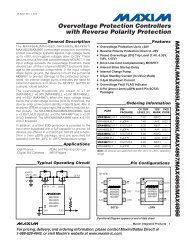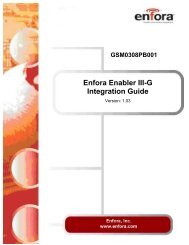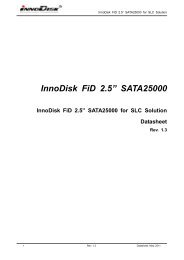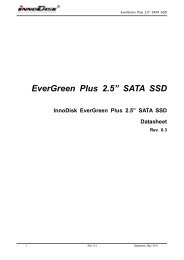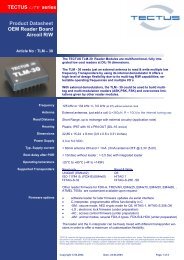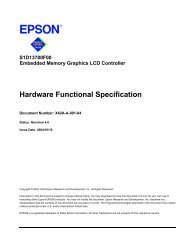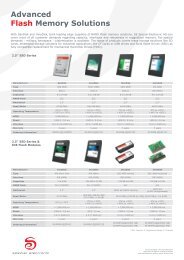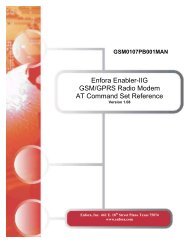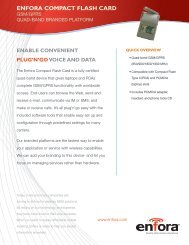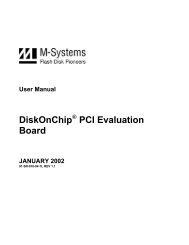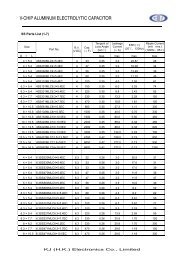Bluetooth I2C Bus Adapterâ¢
Bluetooth I2C Bus Adapterâ¢
Bluetooth I2C Bus Adapterâ¢
Create successful ePaper yourself
Turn your PDF publications into a flip-book with our unique Google optimized e-Paper software.
<strong>Bluetooth</strong> <strong>I2C</strong> <strong>Bus</strong> Adapter<br />
User Manual 3.0<br />
INDUSTRIAL BLUETOOTH
<strong>Bluetooth</strong> <strong>I2C</strong> <strong>Bus</strong> Adapter<br />
User Manual 3.0
Copyright © 2003 connectBlue AB<br />
The contents of this document can be changed by connectBlue AB without prior notice and<br />
do not constitute any binding undertakings from connectBlue AB. connectBlue AB is not<br />
responsible under any circumstances for direct, indirect, unexpected damage or consequent<br />
damage that is caused by this document.<br />
All rights reserved.<br />
Release: 0711<br />
Document version: 3.0<br />
Document number: cBProduct-0710-09 (3)<br />
Printed in Sweden.<br />
Trademarks<br />
Registered trademarks from other companies are: <strong>Bluetooth</strong> is a trademark owned by the<br />
<strong>Bluetooth</strong> SIG, Inc. Microsoft, Windows, Windows NT, Windows 2000, Windows<br />
CE, Windows ME, Windows XP are registered trademarks from Microsoft<br />
Corporation.
Contents<br />
1 INTRODUCTION ..................................................................................... 7<br />
1.1 RELATED DOCUMENTS........................................................................... 7<br />
2 FUNCTIONAL DESCRIPTION ............................................................. 8<br />
2.1 SERIAL INTERFACE................................................................................. 9<br />
2.2 IO PINS................................................................................................... 9<br />
2.3 PROTOCOL OVER AIR.............................................................................. 9<br />
2.3.1 Write Request ................................................................................ 10<br />
2.3.2 Read Request................................................................................. 10<br />
2.3.3 Time Request ................................................................................. 11<br />
2.3.4 Tag Request................................................................................... 11<br />
2.3.5 Combined Requests ....................................................................... 12<br />
2.4 EVENTS................................................................................................. 13<br />
AT COMMANDS REFERENCE .................................................................. 14<br />
2.5 MISCELLANEOUS COMMANDS ............................................................. 14<br />
2.5.1 Read_<strong>I2C</strong>_Setttings (AT*AMIS?) ................................................. 14<br />
2.5.2 Write_<strong>I2C</strong>_Setttings (AT*AMIS=)................................................ 15<br />
2.5.3 Read_<strong>I2C</strong>_Events (AT*AMRIE=)................................................. 15<br />
2.5.4 Write_<strong>I2C</strong>_Event (AT*AMWIE=)................................................. 16<br />
5
1 Introduction<br />
This document describes the functionality of the <strong>Bluetooth</strong> <strong>I2C</strong> <strong>Bus</strong> Adapter. The <strong>Bluetooth</strong><br />
<strong>I2C</strong> <strong>Bus</strong> Adapter is a variant of the standard Serial Port Adapter (SPA) that implements the<br />
master side of the <strong>I2C</strong> bus interface. It is configured, using AT commands, in exactly the<br />
same way as the standard Serial Port Adapter. The <strong>Bluetooth</strong> <strong>I2C</strong> <strong>Bus</strong> Adapter firmware is<br />
available for the following products:<br />
• cB-OEMSPA311<br />
• cB-OEMSPA331<br />
1.1 Related Documents<br />
• The Serial Port Adapter AT Commands document, contains a description of the<br />
AT commands supported in the standard Serial Port Adapter. It also contains<br />
information on how to use the AT commands to create <strong>Bluetooth</strong> applications.<br />
The command line format and data types used for the AT commands are defined<br />
in this document.<br />
• OEM Serial Port Adapter Electrical & Mechanical Datasheet<br />
• <strong>I2C</strong>-<strong>Bus</strong> Specification, version 2.1, January 2000<br />
7
8<br />
2 Functional Description<br />
The <strong>Bluetooth</strong> <strong>I2C</strong> <strong>Bus</strong> Adapter is a variant of the standard SPA that implements the master<br />
side of the <strong>I2C</strong> interface. It provides functionality to <strong>Bluetooth</strong> enable a number of slaves on<br />
an <strong>I2C</strong> bus. Instead of connecting the <strong>I2C</strong> master device directly to the <strong>I2C</strong> bus, the<br />
<strong>Bluetooth</strong> <strong>I2C</strong> <strong>Bus</strong> Adapter is connected. If the previous “master device” supports <strong>Bluetooth</strong><br />
and a simple <strong>I2C</strong> “look-alike” protocol over air, the previous “master device” can access all<br />
<strong>I2C</strong> slaves available on the <strong>I2C</strong> bus over <strong>Bluetooth</strong>.<br />
The <strong>Bluetooth</strong> <strong>I2C</strong> <strong>Bus</strong> Adapter is configured using the same AT commands as for the<br />
standard Serial Port Adapter (see Serial Port Adapter AT Commands document) with some<br />
additions described later in this document.<br />
Typically it is pre-configured once using a toolbox or AT commands, and then mounted and<br />
used for reading and writing data to/from the slaves on the <strong>I2C</strong> bus. 0f course it is also<br />
possible to use it more dynamically and/or to re-configure it over air.<br />
Device with<br />
<strong>Bluetooth</strong><br />
SPP or DUN<br />
Profile<br />
Simple <strong>I2C</strong><br />
“look-alike”<br />
protocol over air.<br />
<strong>Bluetooth</strong><br />
<strong>Bluetooth</strong><br />
<strong>I2C</strong> <strong>Bus</strong><br />
Adapter<br />
<strong>I2C</strong> <strong>Bus</strong><br />
<strong>I2C</strong> Slave <strong>I2C</strong> Slave<br />
Figure 1 The <strong>Bluetooth</strong> <strong>I2C</strong> <strong>Bus</strong> Adapter is connected to the <strong>I2C</strong> bus.<br />
The remote device supports either the SPP or DUN profile and<br />
implements the simple <strong>I2C</strong> “look-alike” protocol over air. The host can<br />
then access all the <strong>I2C</strong> slaves on the <strong>I2C</strong> bus.
2.1 Serial Interface<br />
The serial port of the <strong>Bluetooth</strong> <strong>I2C</strong> <strong>Bus</strong> Adapter is only used to execute AT commands.<br />
Hence, it is not possible to transmit data transparently over air as with the normal serial port<br />
adapter.<br />
Please note that HW flow control is not supported. The CTS pin is instead used as an<br />
external trig signal.<br />
2.2 IO Pins<br />
The following pins differ from the normal serial port adapter.<br />
• Serial Select 0: <strong>I2C</strong> Serial Data (SDA). The SDA pin has a 47kΩ internal pull-up to<br />
VCC (2.9-3.1V). Normally, a 2.2kΩ is more common in <strong>I2C</strong> applications and a<br />
2.2kΩ external pull-up could be used if necessary.<br />
• Serial Select 1: <strong>I2C</strong> clock (SCL). The SCL pin has a 47kΩ internal pull-up to VCC<br />
(2.9-3.1V). Normally, a 2.2kΩ is more common in <strong>I2C</strong> applications and a 2.2kΩ<br />
external pull-up could be used if necessary.<br />
• UART-CTS: External trig input.<br />
• UART-RTS: Not used.<br />
See Electrical and Mechanical data sheet for details.<br />
2.3 Protocol over air<br />
To communicate with the <strong>Bluetooth</strong> <strong>I2C</strong> <strong>Bus</strong> Adapter over air, a simple <strong>I2C</strong> “look-alike”<br />
protocol must be used.<br />
The following request packets are defined:<br />
• Write: Writes data to <strong>I2C</strong> bus.<br />
• Read: Reads data from <strong>I2C</strong> bus.<br />
• Time: Special packet to timestamp response packets.<br />
• Tag: Special packet to set an identifier to a request packet. The identifier is<br />
included in the response packet. Hence, it is possible to identify what response<br />
that is associated with what request.<br />
Each packet consists of a start byte and a stop byte. The start byte is also used as the<br />
request packet identifier. Hence, there are several actual values of a start byte depending on<br />
what packet type it is. The stop byte can be replaced by the start byte of a new packet. A<br />
combined packet is then created. Typically, for <strong>I2C</strong>, this means a repeated write or a<br />
repeated read.<br />
There are also two types of response packets defined.<br />
• ACK: Response to a successfully performed request.<br />
• NAK: Response to an unsuccessfully performed request.<br />
9
10<br />
Note that these packets are only received if there is some data to transmit from e.g. a read<br />
request. If the request only contained an <strong>I2C</strong> write, no response is sent. One way to always<br />
get a response is to create a combined packet with a tag in it. At least the tag will then be<br />
sent back.<br />
2.3.1 Write Request<br />
The write packet executes an <strong>I2C</strong> write operation.<br />
MSB LSB<br />
Write:<br />
0xA1<br />
<strong>I2C</strong> Slave<br />
Address<br />
The data length is specified by the “Data Length” byte.<br />
When the <strong>Bluetooth</strong> <strong>I2C</strong> <strong>Bus</strong> Adapter gets the packet it writes the included data to the<br />
addressed <strong>I2C</strong> slave.<br />
There is no response to this packet. If a response is needed, the request should be combined<br />
with a tag request.<br />
2.3.2 Read Request<br />
The read packet executes an <strong>I2C</strong> read operation.<br />
The data length specifies how many bytes the <strong>Bluetooth</strong> <strong>I2C</strong> <strong>Bus</strong> Adapter should expect<br />
when performing the read operation.<br />
When the <strong>Bluetooth</strong> <strong>I2C</strong> <strong>Bus</strong> Adapter gets the packet it reads the specified number of bytes<br />
and sends an ACK or NAK packet back with the included data. Note that the application<br />
must keep track on what the data is.<br />
The response to this request is.<br />
Data<br />
Length<br />
Data Stop:<br />
0xA3<br />
1 byte 1 byte 1 byte 1 byte<br />
MSB LSB<br />
Read:<br />
0xA2<br />
<strong>I2C</strong> Slave<br />
Address<br />
Data<br />
Length<br />
Stop:<br />
0xA3<br />
1 byte 1 byte 1 byte 1 byte<br />
MSB LSB<br />
ACK: 0xA8<br />
NAK: 0xA9<br />
Data<br />
Length<br />
Data Stop:<br />
0xA3<br />
1 byte 1 byte 1 byte
The “Data Length” byte is the number of bytes in “Data”.<br />
2.3.3 Time Request<br />
The time packet does not execute any <strong>I2C</strong> operations at all. Instead an ACK/NAK packet is<br />
sent back with the time read by the <strong>Bluetooth</strong> <strong>I2C</strong> <strong>Bus</strong> Adapter. Normally, this is only useful<br />
if the packet is part of a combined packet with <strong>I2C</strong> read and/or write operations.<br />
MSB LSB<br />
Time:<br />
0xA4<br />
Stop:<br />
0xA3<br />
1 byte 1 byte<br />
To measure time, the <strong>Bluetooth</strong> <strong>I2C</strong> <strong>Bus</strong> Adapter must continuously keep a timer running.<br />
This affects the stop mode and may not be desirable. Therefore, the time tracking is by<br />
default disabled. If a time request is sent to the module when the time tracking is disabled,<br />
it will return four bytes set to zero.<br />
The response to the time request is.<br />
MSB LSB<br />
ACK: 0xA8<br />
NAK: 0xA9<br />
The time is represented as four bytes (Big Endian) and the measured time is the number of<br />
milliseconds since power on. The “Data Length” byte is 4 for a time response. The timer will<br />
reset after 1 week.<br />
2.3.4 Tag Request<br />
The tag packet does not execute any <strong>I2C</strong> operations at all. Instead an ACK/NAK packet is<br />
sent back with the included tag value. Normally, this is only useful if the packet is part of a<br />
combined packet with <strong>I2C</strong> read and/or write operations. It provides a way to identify what<br />
request that a received response is associated with. Also, it is a way to always get an<br />
ACK/NAK for a write request.<br />
Tag:<br />
0xA5<br />
Data<br />
Length<br />
MSB LSB<br />
Tag Value Stop:<br />
The response to the tag request is.<br />
Time Stop:<br />
0xA3<br />
1 byte 1 byte 1 byte<br />
0xA3<br />
1 byte 1 byte 4 bytes<br />
1 byte<br />
11
12<br />
MSB LSB<br />
ACK: 0xA8<br />
NAK: 0xA9<br />
Data<br />
Length<br />
The returned 1 byte tag value has 1 the byte same value 1 byte as the tag in 1 the byte request. The “Data Length”<br />
byte is 1 for a tag response.<br />
2.3.5 Combined Requests<br />
Tag Value Stop:<br />
Instead of transmitting a separate e.g. write or read request it is possible to combine<br />
different packets into one packet over air. The <strong>Bluetooth</strong> <strong>I2C</strong> <strong>Bus</strong> Adapter will perform<br />
repeated read and write operations on the <strong>I2C</strong> bus for a combined read/write request.<br />
To create combined requests the stop byte of the previous packet is left out and instead the<br />
start byte of the next packet acts as both the stop byte and start byte. It is only the last<br />
request in a combined request that has a stop byte.<br />
For example, assume that a combined request with a tag, <strong>I2C</strong> write, <strong>I2C</strong> read, and time<br />
request shall be created. It then looks like.<br />
Tag:<br />
MSB<br />
0xA5<br />
Tag Value<br />
1 byte 1 byte<br />
Write:<br />
0xA1<br />
<strong>I2C</strong> Slave<br />
Address<br />
The response to the above combined packet will be.<br />
ACK: 0xA8<br />
NAK: 0xA9<br />
Read:<br />
0xA2<br />
0xA3<br />
Data<br />
Length<br />
1 byte 1 byte 1 byte<br />
<strong>I2C</strong> Slave<br />
Address<br />
Data<br />
Length<br />
1 byte 1 byte 1 byte<br />
Data<br />
Length<br />
Tag<br />
Value<br />
Time:<br />
0xA4<br />
1 byte<br />
Data<br />
LSB<br />
Stop:<br />
0xA3<br />
Stop:<br />
1 byte<br />
MSB LSB<br />
Read<br />
Data<br />
Time<br />
0xA3<br />
1 byte 1 byte 1 byte ”Data 4 bytes<br />
1 byte<br />
Length”<br />
from read<br />
packet
The response “Data Length” is the added number of bytes of the tag value, read data and<br />
the time.<br />
Please note that the device that made the request must keep track on what the response<br />
must look like.<br />
2.4 Events<br />
It is possible to store request packets, in the <strong>Bluetooth</strong> <strong>I2C</strong> <strong>Bus</strong> Adapter, associated with<br />
specific events. A request is then executed when its associated event occurs.<br />
Possible events are:<br />
• Power on<br />
• <strong>Bluetooth</strong> connection is setup<br />
• <strong>Bluetooth</strong> connection is terminated<br />
• Periodic – only executed if there is an active <strong>Bluetooth</strong> connection or if the<br />
<strong>Bluetooth</strong> <strong>I2C</strong> <strong>Bus</strong> Adapter is configured for <strong>I2C</strong> interface always enabled.<br />
• External Trig (CTS pin) – only executed if there is an active <strong>Bluetooth</strong> connection<br />
or if the <strong>Bluetooth</strong> <strong>I2C</strong> <strong>Bus</strong> Adapter is configured for <strong>I2C</strong> interface always enabled.<br />
When an event is triggered e.g. a <strong>Bluetooth</strong> connection is setup, the associated request is<br />
executed. The request is a number of bytes that complies to the protocol over air (see<br />
Section 2.3.<br />
For example, assume that a <strong>Bluetooth</strong> <strong>I2C</strong> <strong>Bus</strong> Adapter is connected to a sensor on an <strong>I2C</strong><br />
bus. One configuration could then be:<br />
1. Power on event: The request writes to the control register of the sensor to initialize the<br />
sensor.<br />
2. <strong>Bluetooth</strong> connection is setup: The request writes to the control register of the sensor<br />
to make the sensor leave sleep mode and enter online mode.<br />
3. <strong>Bluetooth</strong> connection is terminated: The request writes to the control register of the<br />
sensor to make the sensor leave online mode and enter sleep mode.<br />
4. Periodic: The request, that is periodically being executed, reads the sensor value, which<br />
is then sent back to the remote device currently connected.<br />
Hence, by using the <strong>I2C</strong> events it is possible to pre-configure the <strong>Bluetooth</strong> <strong>I2C</strong> <strong>Bus</strong> Adapter<br />
to completely control an <strong>I2C</strong> slave without the need for the host device to send a lot of<br />
requests.<br />
13
14<br />
AT Commands Reference<br />
This section describes only the differences in AT commands compared to the standard serial<br />
port adapter.<br />
2.5 Miscellaneous Commands<br />
2.5.1 Read_<strong>I2C</strong>_Setttings (AT*AMIS?)<br />
AT Command Description<br />
AT*AMIS? This command reads the <strong>I2C</strong> settings.<br />
Responses Description<br />
*AMIS:,,<br />
OK<br />
Successful response.<br />
ERROR Error response.<br />
Response<br />
Parameters<br />
Type Value<br />
bit_rate Enumerator 1: Bit rate on <strong>I2C</strong> bus of 100 kbits/s<br />
2: Bit rate on <strong>I2C</strong> bus of 400 kbits/s (default)<br />
enable_time Enumerator Enables the <strong>Bluetooth</strong> <strong>I2C</strong> <strong>Bus</strong> Adapter to track<br />
time since power on.<br />
0: Disabled – Returns time = 0 (default)<br />
1: Enabled – Returns milliseconds since power<br />
on.<br />
Please note that when enabled a timer is running<br />
in the module. This means that the module will<br />
never enter stop mode when there is an active<br />
<strong>Bluetooth</strong> connection.<br />
disable_on_disconnect Enumerator 0: Always let the <strong>I2C</strong> interface be enabled (default)<br />
1: Disable <strong>I2C</strong> interface if there is no <strong>Bluetooth</strong><br />
connection.
2.5.2 Write_<strong>I2C</strong>_Setttings (AT*AMIS=)<br />
AT Command Description<br />
AT*AMIS=, ,<br />
<br />
Command<br />
Parameters<br />
Writes the <strong>I2C</strong> bus interface configuration.<br />
Note that the configuration is always stored in the<br />
startup database.<br />
Type Value<br />
bit_rate Enumerator 1: Bit rate on <strong>I2C</strong> bus of 100 kbits/s<br />
2: Bit rate on <strong>I2C</strong> bus of 400 kbits/s (default)<br />
enable_time Enumerator Enables the <strong>Bluetooth</strong> <strong>I2C</strong> <strong>Bus</strong> Adapter to track<br />
time since power on.<br />
0: Disabled -> Returns time of 0 (default)<br />
1: Enabled -> Returns milliseconds since power<br />
on.<br />
Please note that when enabled a timer is running<br />
in the module. This means that the module will<br />
never enter stop mode when there is an active<br />
<strong>Bluetooth</strong> connection.<br />
disable_on_disconnect Enumerator 0: The <strong>I2C</strong> bus is always enabled (default)<br />
1: Disable <strong>I2C</strong> interface if there is no <strong>Bluetooth</strong><br />
connection.<br />
Responses Description<br />
OK Successful response.<br />
ERROR Error response.<br />
2.5.3 Read_<strong>I2C</strong>_Events (AT*AMRIE=)<br />
AT Command Description<br />
AT*AMRIE= This command reads a pre-configured <strong>I2C</strong> request associated<br />
with an event.<br />
If a pre-configured event is triggered, the associated <strong>I2C</strong> request<br />
is executed.<br />
Responses Description<br />
15
16<br />
*AMRIE: , ,<br />
OK<br />
Successful response.<br />
ERROR Error response.<br />
Response<br />
Parameters<br />
Type Value<br />
event Enumerator 1: Power On<br />
2: <strong>Bluetooth</strong> connection up<br />
3: <strong>Bluetooth</strong> connection down<br />
4: Timer (periodic)<br />
5: External Trig (CTS pin activated)<br />
Note that the Timer and External Trig events are<br />
only executed if there is an active <strong>Bluetooth</strong><br />
connection or if the <strong>Bluetooth</strong> <strong>I2C</strong> <strong>Bus</strong> Adapter is<br />
configured for <strong>I2C</strong> interface always enabled.<br />
period Enumerator The Timer event is periodically executed (if configured)<br />
with this period in milliseconds.<br />
I2c_request_length Enumerator Number of bytes of the <strong>I2C</strong> request.<br />
I2c_request Enumerator <strong>I2C</strong> request where the byte code must apply to<br />
the protocol specified in Section 2.3.<br />
2.5.4 Write_<strong>I2C</strong>_Event (AT*AMWIE=)<br />
AT Command Description<br />
AT*AMWIE=, ,<br />
,<br />
<br />
Response<br />
Parameters<br />
This command configures an <strong>I2C</strong> request.<br />
If a pre-configured event is triggered, the associated<br />
<strong>I2C</strong> request is executed.<br />
Note that the configuration is always stored in the<br />
startup database.<br />
Type Value<br />
event Enumerator 1: Power On<br />
2: <strong>Bluetooth</strong> connection up<br />
3: <strong>Bluetooth</strong> connection down<br />
4: Timer (periodic)<br />
5: External Trig (CTS pin activated)<br />
Note that the Timer and External Trig events are<br />
only executed if there is an active <strong>Bluetooth</strong><br />
connection or if the <strong>Bluetooth</strong> <strong>I2C</strong> <strong>Bus</strong> Adapter is<br />
configured for <strong>I2C</strong> interface always enabled.
period Enumerator The Timer event is periodically executed (if configured)<br />
with this period in milliseconds.<br />
I2c_request_length Enumerator Number of bytes of the <strong>I2C</strong> request.<br />
I2c_request Enumerator <strong>I2C</strong> request where the byte code must apply to<br />
the protocol specified in Section 2.3.<br />
Responses Description<br />
OK Successful response.<br />
ERROR Error response.<br />
17



